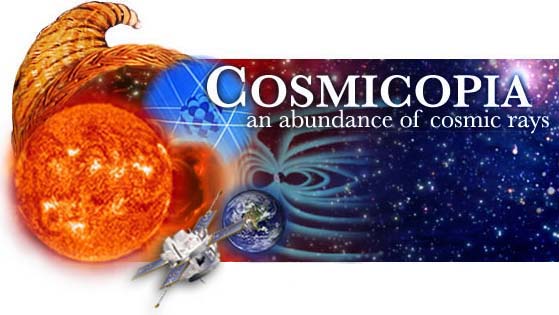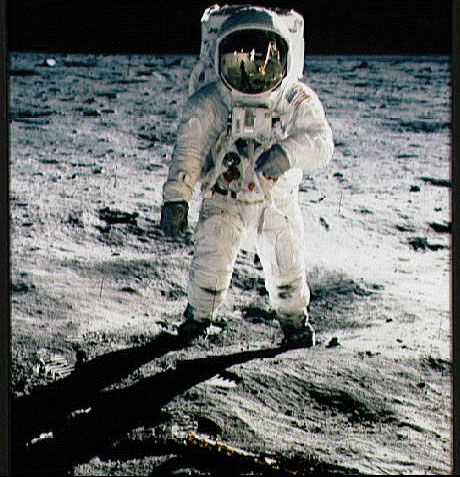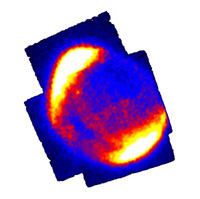
Space Weather
- Ralph Waldo Emerson
Space Weather in the News
Space Weather Activities
Past Geomagnetic Storms
In January 1997, for the first time, a coronal mass ejection was observed in real-time all the way from the Sun to its dramatic consequences at Earth four days later. The SOHO, Wind, Polar, and Geotail spacecraft were all involved. More about this event...
 Magnetic storms produce many noticeable effects on and near the Earth, including the northern and southern lights. This photograph (right) of the Aurora australis (Southern lights) is from Spacelab 3. Photo courtesy of R. Overmyer, NASA.
Magnetic storms produce many noticeable effects on and near the Earth, including the northern and southern lights. This photograph (right) of the Aurora australis (Southern lights) is from Spacelab 3. Photo courtesy of R. Overmyer, NASA.Geomagnetic storms (magnetic storms on Earth due to solar activity) produce the awe-inspiring Aurora borealis and Aurora australis -- the Northern and Southern lights. However, they can also cause a variety of highly undesirable consequences. Electrical current surges in power lines, interference in the broadcast of radio, television, and telephone signals, and problems with defense communications are all associated with magnetic storms. Odd behavior in air and marine navigation instruments has been observed, and a compass anywhere on Earth is certainly affected. These storms are known to alter the atmospheric ozone layer. Even increased pipeline corrosion has been attributed to them.
Variations over the 11-year solar cycle in the intensity of the Sun's electromagnetic output at some wavelengths significantly affect the chemistry, structure, and dynamics of the Earth's upper atmosphere. Longer-term solar variations may be linked to major shifts in the global climate.
 Astronaut Edwin Aldrin walks on the lunar surface near the leg of the Apollo 11 Lunar Module. Courtesy NASA archives.
Astronaut Edwin Aldrin walks on the lunar surface near the leg of the Apollo 11 Lunar Module. Courtesy NASA archives.
Major solar activity is a very serious concern in space flight. Communications may be disrupted. Large solar disturbances heat the upper atmosphere, causing it to expand and create increased drag on spacecraft in low orbits, shortening their orbital lifetime. Spacecraft could potentially tumble and burn up in the atmosphere.
Intense SEP events contain very high levels of radiation, more than a million times the normal daily dose of a human on Earth. Radiation sickness can result when humans are outside the protective magnetosphere of the Earth, as in missions to the moon and to Mars. Monitoring of astronaut's exposure to radiation began during Project Mercury and has continued through the current Shuttle Program. The space radiation environment is very different from that found on Earth. More about radiation dangers to astronauts - from NASA JSC...
High-energy solar protons can produce increased radiation in the atmosphere at altitudes where supersonic aircraft fly. This is especially true for flights over the north and south magnetic poles, areas unprotected by the Earth's magnetic field, where the radiation has direct access to the atmosphere. To reduce the risk to aircraft crews and passengers, and reduce risk to the aircraft, routine forecasts and alerts are sent through the Federal Aviation Administration so that a flight in potential danger can consider what course of action to take to minimize radiation exposure. The National Oceanic and Atmospheric Administration (NOAA) Space Environment Center (SEC) forecasts high-speed solar wind and solar particle events. SEC has a Space Weather Advisories page.
The ACE Real Time Solar Wind (RTSW) experiment also produces on-line geomagnetic storm alerts.
To learn a lot more about space weather, check out our question and answer page on space weather in our "Ask Us" feature.
Other great space weather links:
- Space Weather Now -- National Oceanic and Atmospheric Administration (NOAA) Space Environment Center
- Secrets of the Polar Aurora -- David Stern
- Basic Facts About Space Weather -- Windows to the Universe
- Space Weather -- Rice University
- SpaceWeather.com -- Marshall Space Sciences Lab
- Space Weather Center -- Space Science Institute
- Space Weather Today -- Windows to the Universe
- Surviving in Space -- National Geographic
- AGU Space Weather -- The International Journal of Research and Applications
 Space Weather in the News
Space Weather in the News
January 5, 2009: New study reveals hazards of severe space weather -- NASA
December 16, 2008: Sun often "tears out a wall" in Earth's solar storm shield -- NASA THEMIS
December 8, 2008: Automated real-time shock analysis for space weather alerts -- ACE News
November 21, 2008: Mars Express observes aurora on the red planet -- Science Daily
November 19, 2008: Unusual auroras over Saturn's north pole -- APOD
November 12, 2008: Cassini finds mysterious new aurora on Saturn -- NASA
November 12, 2008: Rocket launching to investigate the northern lights -- Science Daily
November 4, 2008: "Star Trek" shield may protect astronauts -- National Geographic
November 4, 2008: May the force (field) be with you -- Scientific American
October 30, 2008: Hot solar wind in cold outer space -- The Weather Channel
October 27, 2008: Halloween storms of 2003 still the scariest -- NASA
September 5, 2008: NASA to explore "secret layer" of the Sun -- Science@NASA
August 19, 2008: Living with a star -- Science@NASA
July 29, 2008: Timeline: The 1859 solar superstorm -- Scientific American
July 28, 2008: Bracing the satellite infrastructure for a solar superstorm -- Scientific American
July 25, 2008: The secrets of the northern lights -- Astronomy.com
July 24, 2008: Aurora "power surges" triggered by magnetic explosions -- National Geographic
July 24, 2008: NASA satellites discover what powers northern lights -- NASA HQ
July 21, 2008: APL-led team wins NSF grant to develop new observatory for Earth's space environment -- JHU APL
July 1, 2008: Solar Shield experiment aims to keep the power on -- NASA GSFC
June 30, 2008: Satellites pinpoint Earth's auroral radio chatter -- Scientific American
June 18, 2008: GPS inaccurate during space storms -- Space.com
June 18, 2008: The mystery of Satern's double aurorae -- Sky & Telescope
June 9, 2008: Radio waves from Earth clear out space radiation belt -- New Scientist
June 5, 2008: Communications glitch delays Mars lander digging -- Physorg
June 5, 2008: Military transmitter points to flare cure -- Australian Broadcasting Company
May 29, 2008: NASA scientists' model reveals how plasma from superstorms affect near-Earth space -- NASA GSFC
May 6, 2008: A super solar flare -- Science@NASA
April 30, 2008: 4D ionosphere -- Science@NASA
April 29, 2008: Is there a hidden order to the northern lights? -- New Scientist
April 28, 2008: "Broken heart' image the last for NASA's long-lived Polar mission -- NASA GSFC
April 24, 2008: Northern lights glimmer with unexpected trait -- AGU
April 18, 2008: Design begins on twin probes that will study the radiation belts -- JHU/APL
April 15, 2008: Sky delights over Sweden -- APOD
April 14, 2008: Mission to Mars -- GSI
April 5, 2008: Magnetic substorms from ground and space -- Science Daily
April 2, 2008: Hinode: Source of the slow solar wind and superhot flares -- ESA
March 20, 2008: Spring is aurora season -- Science@NASA
March 6, 2008: Auroras in broad daylight -- Science@NASA
March 5, 2008: Spring is aurora season -- Astronomy.com
March 5, 2008: Scientists identify origin of hiss in upper atmosphere -- Eurekalert
March 3, 2008: NASA's SDO mission to improve predictions of violent space weather -- NASA GSFC
February 25, 2008: Killer electrons surf celestial tsunamis -- NASA GSFC
February 13, 2008: SOHO data used for real-time space radiation forecasting -- ESA
February 1, 2008: The first Explorer -- APOD
January 31, 2008: New discovery on magnetic reconnection to impact future space missions -- Science Daily
January 29, 2008: Space weather science rues cuts -- BBC
January 7, 2008: 'Maverick' sunspot heralds new solar cycle -- New Scientist
January 2, 2008: Third instrument for NASA's Solar Dynamics Observatory arrives at Goddard -- NASA GSFC
January 1, 2008: Rays from an unexpected aurora -- APOD
December 13, 2007: Earth's magnetosphere: On the ropes -- Sky & Telescope
December 11, 2007: NASA spacecraft make new discoveries about Northern Lights -- Eurekalert
December 11, 2007: Brain stem cells sensitive to space radiation -- Eurekalert
November 29, 2007: Barren land: Why Venus is lifeless -- Economist
November 28, 2007: UNH scientists report first findings on key astrophysics problem -- Eurekalert
November 19, 2007: Aurora in the distance -- APOD
November 13, 2007: Strange space weather over Africa -- Science@NASA
September 30, 2007: Tiny animals exposed to outer space -- Science Daily
September 12, 2007: Cluster and Double Star uncover more on bright aurorae -- Science Daily
August 31, 2007: Scientists find elusive waves in Sun's corona -- Science Daily
August 27, 2007: Flares from Sun's far side may affect space weather of inner planets -- Science Daily
July 27, 2007: Killer electrons in space are now less mysterious -- Science Daily
May 30, 2007: Radio 'screams' from the Sun warn of radiation storms -- EurekAlert!
May 29, 2007: Screaming CMEs warn of radiation storms -- NASA GSFC
May 25, 2007: Spacecraft aids in forecast of solar radiation storms -- NASA HQ
May 25, 2007: The ions are coming! -- Science@NASA
April 13, 2007: Cluster sees tsunamis in space -- SpaceDaily
April 9, 2007: Aurora over Alaska -- NASA GSFC APOD
April 4, 2007: Researchers find Global Positioning System is significantly impacted by powerful solar radio burst -- NOAA News
March 30, 2007: Sun burp blasted ozone layer in 1859 -- Australian Broadcasting Company
March 22, 2007: Hinode studies the Sun -- Astronomy.com
March 21, 2007: Solar activity won't break drought -- Australian Broadcasting Company
March 21, 2007: Clemson rocket launches test Alaskan auroras -- SpaceDaily
March 15, 2007: UD physicist wins NSF Career Award for space weather research -- EurekAlert!
March 14, 2007: THEMIS weighs in on the Northern Lights -- EurekAlert!
March 2, 2007: Space weather in STEREO -- Astronomy.com
February 20, 2007: THEMIS satellites put Berkeley physicist in pole position to study aurora like never before -- SpaceDaily
February 19, 2007: International Heliophysical Year begins -- European Space Agency
February 16, 2007: NASA THEMIS mission adds five spacecraft to the Sun-Earth flotilla -- European Space Agency
February 9, 2007: Cluster - new insights into the electric circuits of polar lights -- European Space Agency
February 7, 2007: NASA-European spacecraft swoops under Sun's pole -- NASA JPL
February 2, 2007: Sophisticated ESA space weather tool under development -- European Space Agency
January 30, 2007: Northern lights research enters final frontier -- SpaceDaily
January 30, 2007: University of Alberta space research to solve aurora mystery -- SpaceDaily
January 17, 2007: THEMIS will judge what causes highly dynamic aurora -- NASA GSFC
January 5, 2007: US researchers study space weather -- SpaceDaily
January 4, 2007: 1000th orbit for the Cluster mission -- SpaceDaily
Space Weather Activities
Grades 7 - 9: Auroras and Magnetic Storms -- NASA IMAGE
Grades 7 - 9: Cosmic Radiation Creates Unfriendly Skies -- NASA IMAGE
Grades 7 - 9: Magnetic Storms From the Ground -- NASA IMAGE
Grades 7 - 9: Planning a Trip to Mars -- NASA IMAGE
Grades 7 - 9: Satellite Glitches and Cosmic Rays _- NASA IMAGE
Grades 7 - 9: Solar Storms and Satellites -- NASA IMAGE
Grades 9 - 12: Space Weather -- NASA GSFC
Grades 9 - 12: Space Weather and YOU! Introduction 2 -- NASA GSFC
Grades 9 - 12: Space Weather and YOU! -- NASA GSFC
Past Geomagnetic Storms
JULY 14-16, 2000 from the ACE Science Center
JULY 14-16, 2000 from IMP-8
JULY 14-16, 2000 from ISTP
JUNE 8, 2000 from the ACE Science Center
JUNE 6-9, 2000 from ISTP
APRIL 6, 2000 from the ACE Science Center
APRIL 4-7, 2000 from ISTP







Questions and comments to: cosmicopia@cosmicra.gsfc.nasa.gov
Curator: Beth Barbier, SP Systems
Responsible NASA Official: Dr. Tycho von Rosenvinge
Privacy Policy and Important Notices

HOME
In the News
History
Ask Us
Great Links
Glossary
Site Map
Search NASA